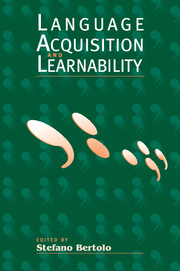5 - The Structural Triggers Learner
Published online by Cambridge University Press: 15 October 2009
Summary
Introduction
How much work does it take to acquire a human language? For most adults, the acquisition of a new language is a slow and effortful process. But what if one has the right learning equipment, as children evidently do? For first language learners most of the work is done in five or six years. Our research goal is to find out what goes on in those few years. To what extent does it involve the use of special-purpose computational systems that adults lack? What do the learning routines do that is so difficult for the human brain to simulate later in life?
We will argue here that very little need be done to acquire a language, over and above the normal processes of comprehension that are involved in all language use. At least, we will argue this for the acquisition of syntax, on the assumptions that the syntactic component of a natural language grammar is largely innate and that learning consists exclusively of the setting of parameters. Similar conclusions could apply to any other parameterized domain, such as phonology (see Dresher and Kaye, 1990; Dresher, 1999). Acquisition of the lexicon is likely to be a different and more labor-intensive project. And semantic principles possibly demand no learning at all.
Thus, we assume here the principles-and-parameters framework for language description (Chomsky, 1981a, 1988, and elsewhere) and consider the process by which syntactic parameters are set.
- Type
- Chapter
- Information
- Language Acquisition and Learnability , pp. 172 - 233Publisher: Cambridge University PressPrint publication year: 2001
- 22
- Cited by



